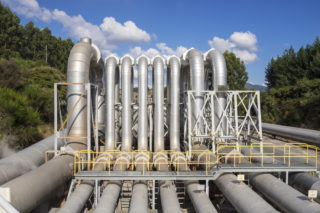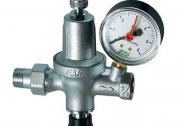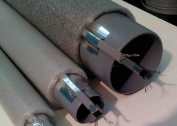Pipelines are a special system of structures designed for the transportation, processing and disposal of substances in different state of aggregation: gaseous, liquid and solid. All equipment is divided into different types and categories, which have individual technical characteristics and limitations.
Purpose of pipelines and their features
Pipelines of steam and hot water are designed for heating facilities, storage and industrial premises. The most common material from which the pipeline system is made is steel, but other materials exist.
The medium transported through these pipes, as a rule, has a temperature above 100 degrees. The overpressure parameter in the pipeline communication reaches 1.6 MPa. New objects are made of steel, since the material has high resistance to mechanical stress, reliable in use and durable. To improve the technical characteristics of the materials are subjected to heat treatment. This manipulation reduces the risk of water hammer. The project documents indicate the applicable heat treatment mode.
However, heat treatment is not carried out in all cases. Exceptions occur for the following reasons:
- The necessary technical parameters are achieved at the stage of production of pipes and parts.
- At the manufacturing stage, the pipe was heat treated by hot forming.
Water hammer is an emergency situation, accompanied by depressurization of the system, which entails the leakage of steam and gas. Therefore, technical specifications must comply with the standards.
Categories of steam and hot water pipelines, types of heating systems
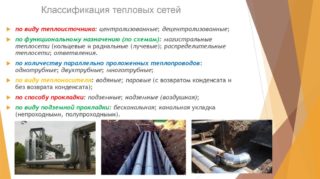 Pipelines designed for hot environments have 4 classifications. Technical parameters, according to which the calculation of a particular communication is performed:
Pipelines designed for hot environments have 4 classifications. Technical parameters, according to which the calculation of a particular communication is performed:
- Hot water pipes (return and selling) - have the highest permissible temperature or pressure, the terrain and the type of pumping station are taken into account.
- For a system transporting steam from boilers with operating parameters, the temperature and pressure of the medium at the outlet are calculated.
- For a water supply system that transfers feed water after pressurized diaerators, the nominal pressure is taken into account based on the technical parameters.
- For steam communications operating from turbines, an indicator of pressure at idle temperature and backpressure is important.
- For a piping system transporting steam from a reduction-cooling and reduction installation, an indicator of the temperature and pressure of the medium is taken into account.
There are also exceptions when non-compliance with the rules is allowed, but they require a clear explanation for deviating from the laws.
Classification of heating systems
Separation of heating systems is carried out according to the following factors:
- design, availability of circuitry;
- heat source;
- type of gasket;
- workspace.
Depending on the heat source:
- decentralized (autonomous boiler rooms);
- centralized (operating from a nuclear or thermal station).
Structures that transport hot media have one individual feature - a clear number of pipes in the entire pipeline system. This is due to the fact that in addition to moving the working medium, the design must have a branch.
The pipeline for steam has a complex system of work and, accordingly, the design. This is due to the fact that the working medium reaches a temperature that exceeds the permissible temperature of the water. As a result of strong heating, if the design is not designed correctly, deformation of the pipes is possible. Also take into account the formation on the walls of pipes and parts of condensate.
According to the principle of laying a heating system there are:
- underground (hidden);
- aboveground (open).
Open pipeline systems, as a rule, are carried out in those conditions when it is necessary to secure communication from mobile (seismically active) underground soils, as well as in densely built-up areas.
Rules for the design and safe operation of steam and hot water pipes
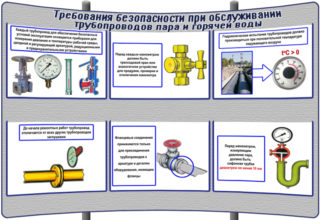 Design and installation of the system is carried out in accordance with building codes and rules. When making calculations, the following parameters are taken into account:
Design and installation of the system is carried out in accordance with building codes and rules. When making calculations, the following parameters are taken into account:
- weight of the pipeline;
- permissible temperature conditions;
- value of working and admissible pressure;
- expansion of metals under the influence of high temperatures.
Based on the data obtained, specialists calculate the operating life of the pipeline and record it in the passport. The pipeline must be designed in such a way as to carry out monitoring and regular professional examinations were not difficult. Elements of pipelines are welded by welding.
Flange and threaded connections are used if the parts are equipped with flanges. It is also worth considering that the details of the pipeline are pre-treated with a tool that prevents corrosion processes. All areas where the temperature is above 55 degrees should be thermally insulated.
Hidden installation
When laying the pipeline in a semi-bore trench, it should be borne in mind that its height should be at least 1.5 meters, and the minimum allowable interval between insulated pipes is approximately 60 cm.
The sections on which the shutoff valves are mounted are placed in thickened places of the tunnel in order to regularly inspect and repair breakdowns.
Ground method of laying communications
If there is an open installation of a pipeline through which liquid and high temperature steam will move, it is necessary to strictly observe the rules prescribed in SNiP. Terrestrial installation in contrast to the hidden installation allows the joint laying of different types of communication networks.
Most often, an onshore pipeline is conducted on the territory of industrial enterprises. Involve only in cases where there is no opportunity to conduct communications in a hidden way.
Ground-based installation is carried out in the following cases:
- geographically, the site is located in permafrost;
- high groundwater stagnation;
- seismic activity.
An open installation method has a significant advantage compared to the underground one - saving financial costs, as a rule, they are 40% less.
